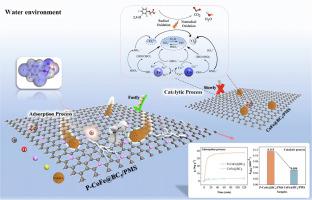Journal of Colloid and Interface Science ( IF 9.4 ) Pub Date : 2023-04-05 , DOI: 10.1016/j.jcis.2023.03.181 Xuetao Liang 1 , Yujie Zhao 1 , Jing Liu 1 , Zhilin Yang 2 , Qi Yang 1

|
The dispersing effect of carbon materials on nanoparticles can enhance the full exposure of their active sites. Herein, phosphorus (P)-doped activated carbon-supported trace cobalt ferrite composites (P-CoFe@BCX) were achieved by two-step pyrolysis for efficient peroxymonosulfate (PMS) activation and water pollution remediation. The removal efficiency of 2,4-dichlorophenoxyacetic acid (2,4-D) was optimized by adjusting the coupling ratio of carbon substrate and cobalt ferrite. P-CoFe@BC5/PMS oxidation system (0.10 g L-1, 0.50 mM) eliminated 98.3% of 2,4-D (20.0 mg L-1) within 60 min at unadjusted pH. The constructed adsorption enrichment and oxidative degradation pathways are highly efficient in utilizing reactive oxygen species (ROS), and the dual tracks of free and non-free radicals achieve the rapid degradation of 2,4-D. P-doped activated carbon acts as an electron shuttle to accelerate electron transfer between active sites and enhances the adsorption efficiency of 2,4-D and PMS onto the composites. In addition, the P-CoFe@BC5/PMS oxidation system still exhibited strong 2,4-D removal performance at a wide pH range of 2.0-10.0. The inhibitory effect of environmental components was related to their concentration, such as chloride, bicarbonate, sulfate and humic acid. Density functional theory calculations show that ROS tends to attack the C-O bond on the 2,4-D branch chain, and the degradation products show lower biological toxicity. Hence, the constructed cobalt ferrite anchored P-doped activated carbon activated PMS system has great potential in treating organic wastewater.
中文翻译:

固定在 P 掺杂活性炭中的钴铁酸盐高效活化过氧单硫酸盐以降解 2,4-D:吸附和电子转移机制
碳材料对纳米粒子的分散作用可以增强其活性位点的充分暴露。在此,磷 (P) 掺杂活性炭负载的微量钴铁氧体复合材料 (P-CoFe@BC X ) 通过两步热解实现,用于有效的过一硫酸盐 (PMS) 活化和水污染修复。通过调节碳底物与铁酸钴的偶联比,优化了2,4-二氯苯氧乙酸(2,4-D)的去除效率。P-CoFe@BC 5 /PMS 氧化系统 (0.10 g L -1 , 0.50 mM) 消除了 98.3% 的 2,4-D (20.0 mg L -1) 在未经调整的 pH 值下 60 分钟内。构建的吸附富集和氧化降解途径高效利用活性氧(ROS),自由基和非自由基双通道实现2,4-D的快速降解。P 掺杂活性炭充当电子穿梭机,加速活性位点之间的电子转移,并提高 2,4-D 和 PMS 在复合材料上的吸附效率。此外,P-CoFe@BC 5/PMS 氧化系统在 2.0-10.0 的宽 pH 范围内仍然表现出很强的 2,4-D 去除性能。环境成分的抑制作用与其浓度有关,如氯化物、碳酸氢盐、硫酸盐和腐殖酸。密度泛函理论计算表明ROS倾向于攻击2,4-D支链上的CO键,降解产物表现出较低的生物毒性。因此,构建的钴铁氧体锚定P掺杂活性炭活性PMS系统在处理有机废水方面具有巨大潜力。





















































 京公网安备 11010802027423号
京公网安备 11010802027423号